Ever found yourself wondering how to get started with zero-waste living as you stare at the overflowing trash bin at the end of the week? You’re not alone. This concept is key to turning the tide against our throwaway culture.
The 5 R’s of zero-waste living are Refuse, Reduce, Reuse, Repurpose, and Recycle. This framework guides individuals towards making conscious decisions to minimize waste and live more sustainably by prioritizing the prevention of waste creation and encouraging the efficient use of resources.
Curious about how you can incorporate these 5 R’s into your daily life and make a real difference? Our guide breaks down each principle with practical tips, real-life examples, and creative ideas to inspire and empower your zero-waste journey. Dive in to discover how simple changes can lead to impactful environmental benefits.
The Principle of Zero-Waste Living
According to the World Economic Forum, “Zero-waste refers to principles of minimizing waste production as much as possible.” Béa Johnson of Zero Waste Home calls the framework for zero-waste the 5 Rs: refuse, reduce, reuse, recycle, and rot. In reality, before the rise of plastic production in the mid-20th century, many people naturally followed a zero-waste approach to waste management.
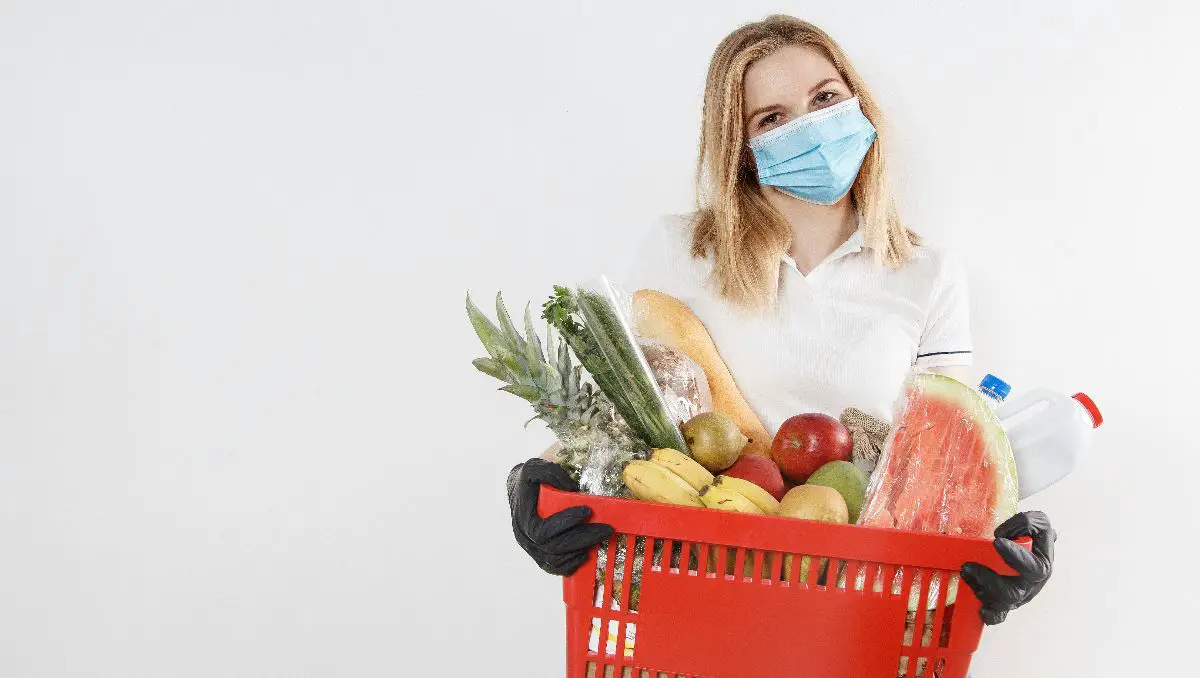
The principle of zero-waste living stems from a critical look at our current linear economy, where goods are manufactured, used, and then disposed of in a “take-make-waste” fashion. This philosophy advocates for a shift towards a circular economy, where every product is designed to be repurposed, repaired, or recycled back into the system, minimizing waste to the greatest extent possible.
The zero-waste rules are not just about waste reduction but about rethinking our relationship with resources altogether. It challenges individuals, communities, and businesses to consider the full lifecycle of products and to innovate in ways that keep materials in use for as long as possible.
As more people embrace zero-waste living, they contribute to a growing movement that pressures manufacturers and policymakers to prioritize sustainability and resource efficiency. Ultimately, the goal is to create a more sustainable world where waste is viewed not as an inevitable byproduct of living but as a design flaw that can and should be corrected.
The 5 R’s of Zero-Waste Living
The journey towards zero-waste living can be broken down into five actionable steps, known as the 5 R’s: Refuse, Reduce, Reuse, Repurpose, and Recycle. These steps are designed to be followed in order, prioritizing the prevention of waste creation before considering disposal. Let’s dive into each of these R’s to understand how you can incorporate them into your daily life.
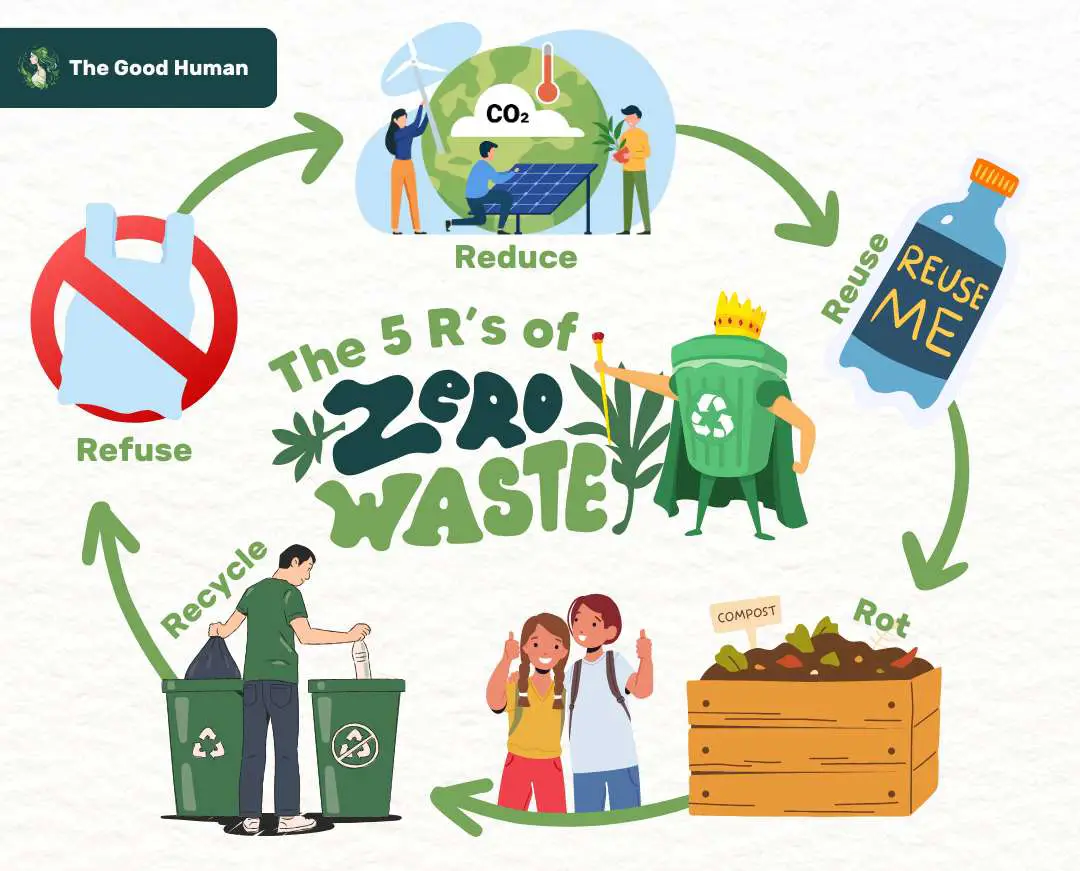
1. Refuse
Refusing unnecessary items is the first and most effective step in zero-waste living. It’s about saying no to things you don’t need, especially single-use items like plastic straws, cutlery, and bags, as well as junk mail and promotional items that clutter your space. By refusing, you minimize waste at its source, preventing items from becoming part of the waste stream.
Practical tips for refusing waste include carrying your own reusable alternatives, like water bottles and shopping bags, and opting out of unsolicited mail lists. It might feel awkward at first to say no, but remember, each time you refuse disposable items, you’re making a positive impact. Real-life examples include declining plastic straws at restaurants, bringing your own containers for takeout, and setting up a no junk mail sign on your mailbox. These small acts can inspire others to follow suit, creating a ripple effect of waste reduction.
2. Reduce
Reducing your overall consumption is the next step in zero-waste living. This doesn’t just mean buying less; it’s about making mindful choices that lead to less waste. Consider the necessity and lifespan of everything you purchase, aiming for items that are durable, reusable, and truly needed.
Reducing consumption can also mean decluttering your life, letting go of items you don’t use while being careful not to replace them impulsively. This approach not only lightens your environmental footprint but can also lead to a simpler, more focused lifestyle. By prioritizing quality over quantity, you can significantly cut down on the amount of waste you generate, setting a sustainable example for those around you.
Here are more examples focused on the ‘Reduce’ principle:
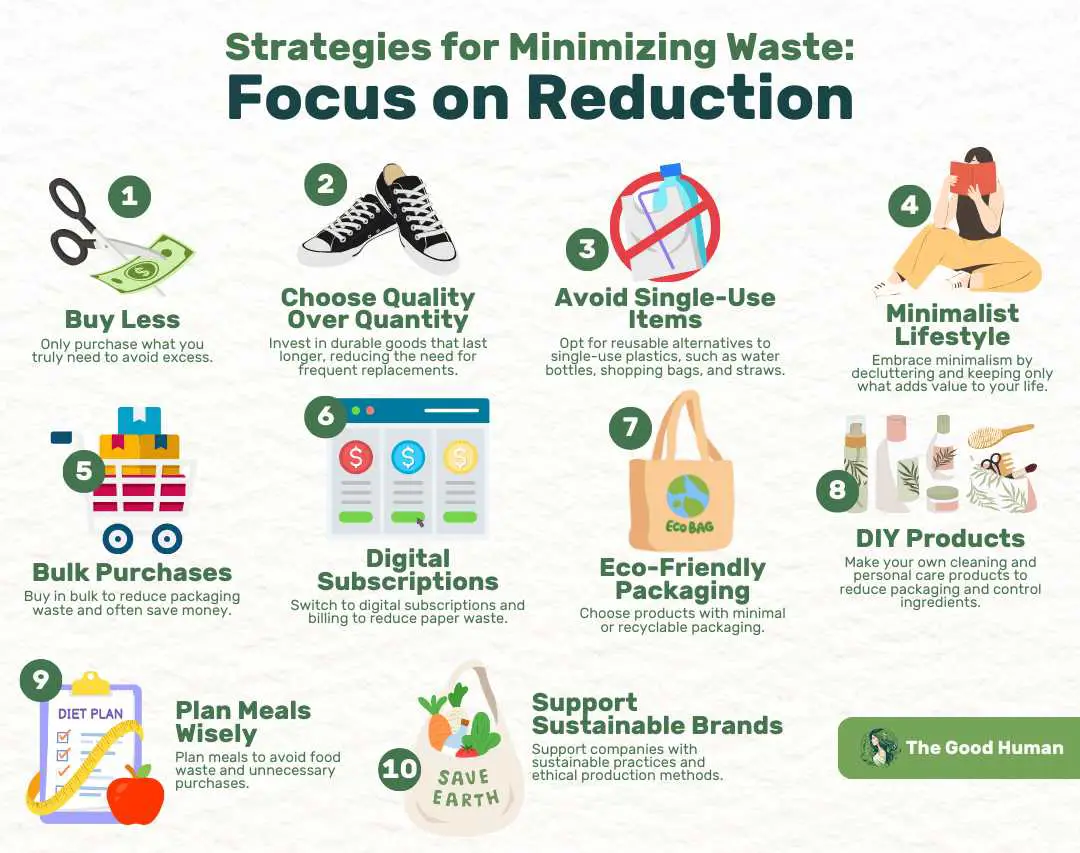
3. Reuse
Reusing items, rather than discarding them, extends their life and reduces the need for new products. This can be as simple as using glass jars for storage or as complex as refurbishing furniture. The benefits of reusing are immense, saving resources, and reducing pollution.
Look for opportunities to repurpose items at home and work, and support community initiatives like tool libraries and repair cafes, which help share resources and knowledge. Creative reuse involves seeing the potential in objects that might otherwise be considered trash. For example, an old ladder can become a bookshelf, and empty glass bottles can turn into candle holders. By integrating reuse into your routine, you not only save money but also foster a culture of resourcefulness and sustainability.
Take note that you can’t possibly reuse everything you have at home. To help you decide, here’s a simple decision-making tool you can use as a guide:
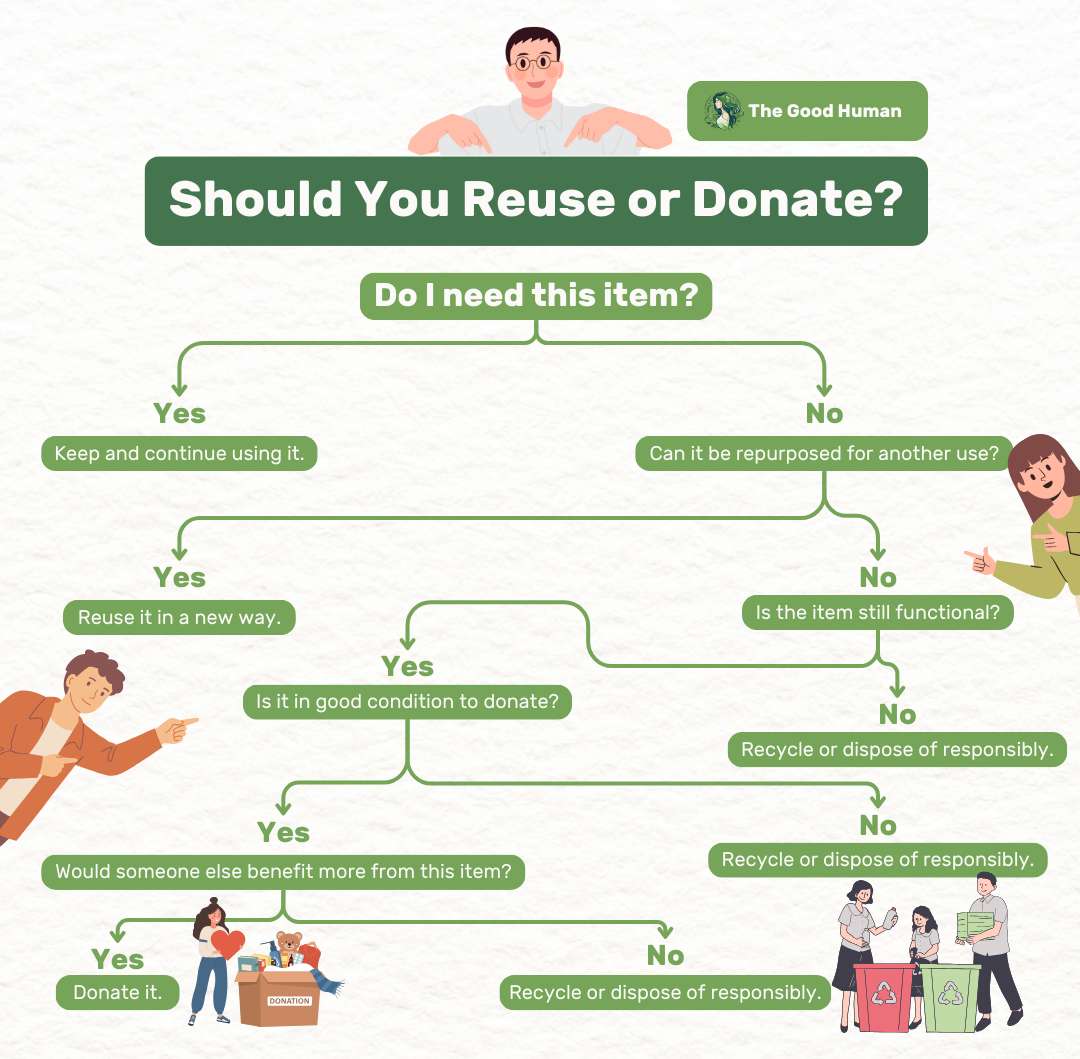
4. Repurpose
Repurposing is about giving an old item a new function, differentiating it from simple reuse by adding creativity and innovation. It’s a fun and engaging way to reduce waste, allowing you to express your personality and values through DIY projects. For instance, turning jars into planters or old clothes into quilts not only gives items a second life but also reduces the need for new materials.
Highlighting innovative repurposing projects can inspire others to think outside the box when it comes to waste. Whether it’s converting old books into unique shelves or using bicycle parts for wall art, these projects show that with a little imagination, you can transform waste into something beautiful and functional. Plus, sharing your projects can motivate your community to consider repurposing as a viable alternative to discarding.
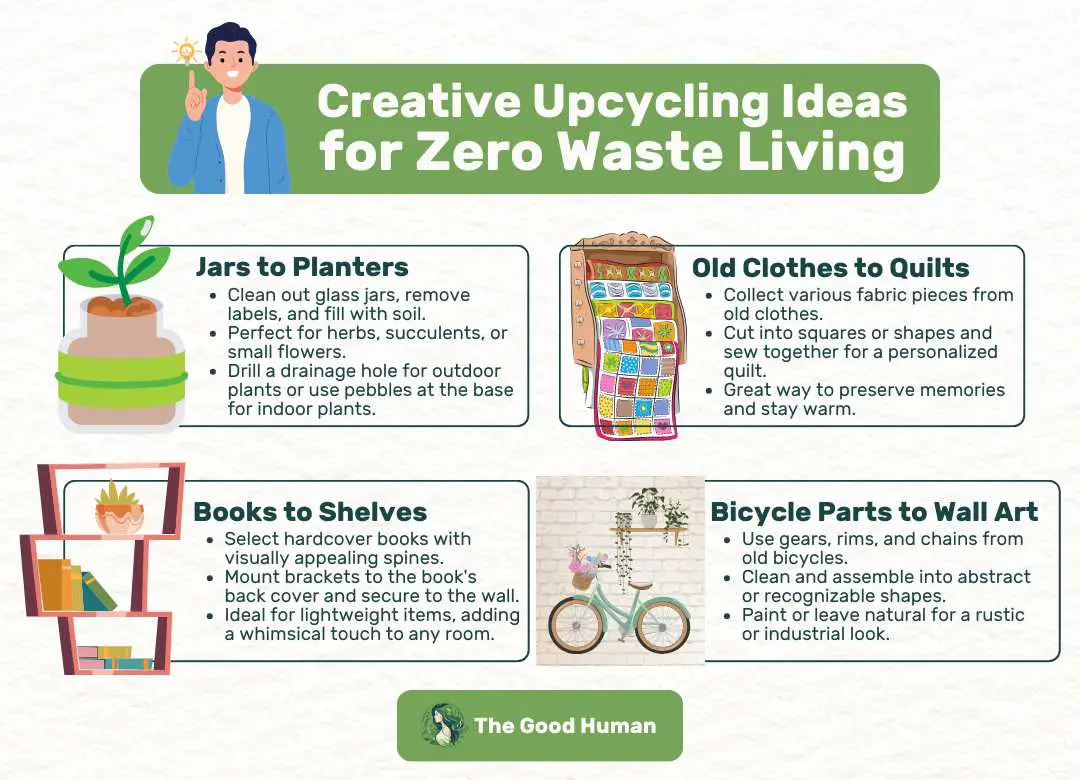
5. Recycle
Recycling is the last resort in the zero-waste hierarchy but still plays a crucial role in managing waste sustainably. Understanding what can and cannot be recycled in your area is key to recycling efficiently. Not everything with a recycle symbol is accepted in local programs, and contamination can render batches of recyclables useless.
To recycle effectively, familiarize yourself with local guidelines, clean items before recycling, and avoid wish-cycling—hoping non recyclable items can somehow be recycled. Recycling correctly ensures that materials like paper, glass, and metals are reprocessed into new products, conserving resources, and reducing the need for raw materials. Remember, the ultimate goal of zero-waste is not to recycle more, but to need to recycle less by prioritizing the other R’s first.
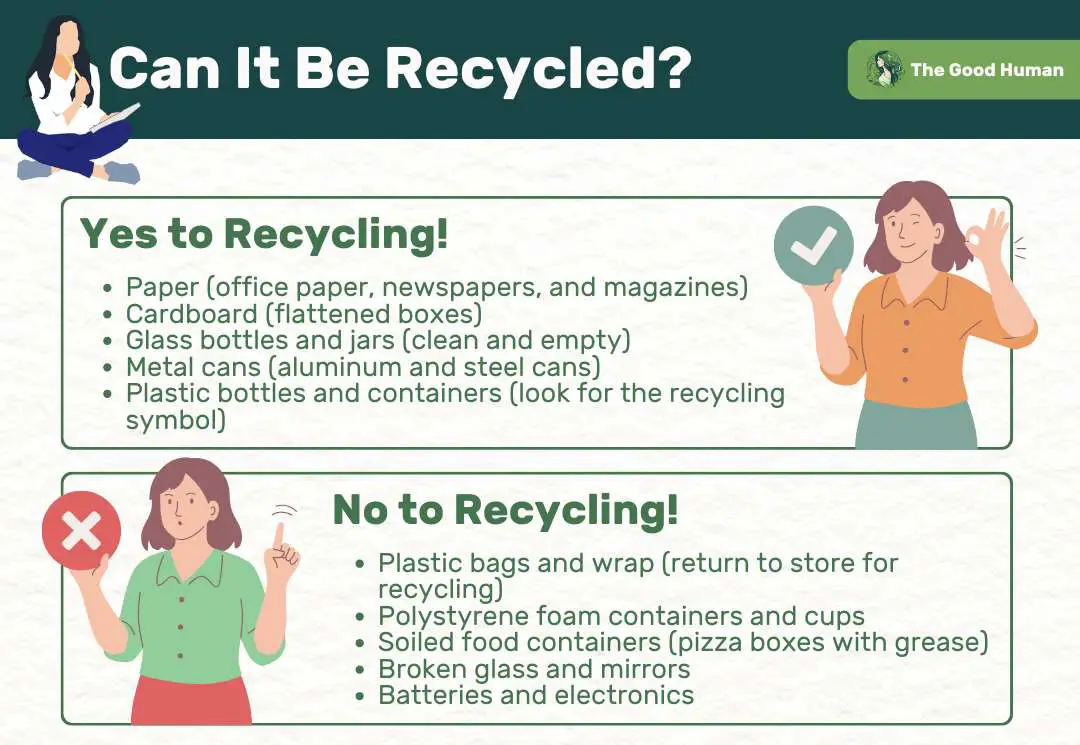
Implementing the 5 R’s in Everyday Life
Bringing the 5 R’s of Zero-Waste Living into your daily routines may seem daunting at first, but with a step-by-step approach, it becomes manageable and even enjoyable. It’s about making small, conscious changes that collectively make a significant impact over time. Let’s explore how you can seamlessly integrate these principles into your life, making zero-waste living a practical and fulfilling endeavor.
Step-by-step guide to incorporating the 5 R’s into daily routines
Start your zero-waste journey by focusing on one ‘R’ at a time.
- Beginning with ‘Refuse,’ make it a habit to decline single-use plastics and unnecessary freebies.
- Then, move on to ‘Reduce’ by assessing your needs and minimizing your consumption of goods.
- Gradually, incorporate ‘Reuse’ by opting for durable, reusable products over disposables.
- As you become comfortable with these changes, explore ‘Repurpose’ by getting creative with items you might otherwise throw away.
- Finally, perfect your ‘Recycle’ practices by learning your local recycling rules and following them diligently.
Remember, the goal is progress, not perfection. Each small step you take is a victory for the planet. Overcoming the initial resistance to change is perhaps the biggest challenge in adopting zero-waste habits. You might worry about convenience, cost, or feeling overwhelmed by the changes you need to make.
Start small and focus on achievable goals, like bringing your own bags to the grocery store or refusing plastic straws. As you gain confidence, gradually introduce more changes. Remember, every action counts, and setbacks are just part of the journey. Reach out to online communities or local groups for support and ideas. These networks can offer valuable advice, encouragement, and a sense of belonging to a larger movement.
Tips for staying motivated and making sustainable choices
Staying motivated on your zero-waste journey requires focusing on the positive impact of your actions. Celebrate your successes, no matter how small, and remember why you started. Visual reminders of your goals, such as images of wildlife or nature, can reinforce your commitment to protecting the environment.
Setting realistic, incremental goals can also help maintain momentum. For example, aim to reduce your household waste by a certain percentage each month. Lastly, involve friends and family in your efforts. Sharing the journey not only makes it more enjoyable but also spreads the zero-waste ethos further.
Final Thoughts
Adopting a zero-waste lifestyle is an ongoing process of learning, experimenting, and growing. It’s not about achieving perfection but making consistent, conscious efforts to minimize waste. The 5 R’s provide a framework to guide these efforts, but the journey is uniquely yours.
Remember, each small change contributes to a larger collective impact. By embracing zero-waste living, you’re taking an active role in creating a more sustainable future for ourselves and generations to come. Let’s cherish our planet by choosing to live with intention and care, one decision at a time.






